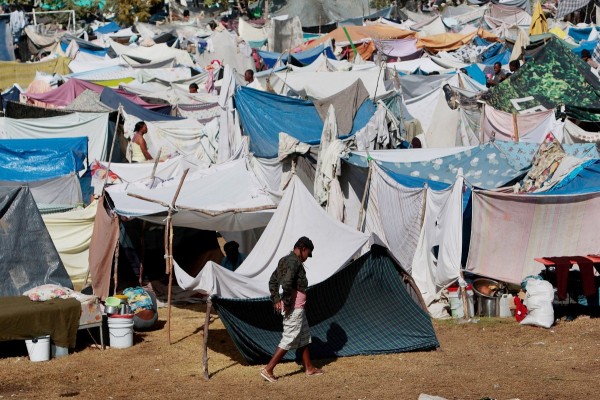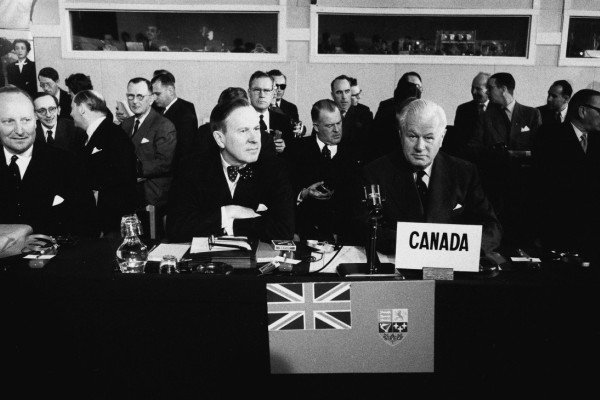Digging Up Canadian Dirt in Colombia
Up a flight of stairs, behind double-enforced bulletproof glass and a large, silent bodyguard sits the office of Francisco Ramirez, a mining-policy researcher and president of a small Colombian trade union.
Mining policy really isn’t sexy stuff and researching it usually isn’t a dangerous occupation, but some of Mr. Ramirez’s conclusions can mean life or death literally and figuratively. “Once they tried to kill me right here in this office,” said the researcher, who has survived seven assassination attempts.
In Colombia’s mineral-rich underworld, often demarcated by the full-scale destruction of towns near mining sites, environmental contamination, parami-litary attacks and assassinations against those who stand up to mining interests, Canadian hands are dirtier than those of a coal miner coming up from the pit. “We had a five-year, $11-million project in Colombia, which ran from 1997 to 2002,” said a senior official with the Canadian International Development Agency (CIDA), who spoke on condition of anonymity. “Basically, it was to help Colombia strengthen its institutional capacity in both the Ministry of Mines and Energy and the Ministry of the Environment and the regulatory agencies these agencies worked with,” said the CIDA official in a phone interview.

If my UPME source is correct that regular taxes are the key component for government mining earnings, then Article 229 essentially decapitates the state’s ability to garner public good from the exploitation of non-renewable resources.
Because of the constant public-education efforts by people like Francisco Ramirez and institutions like Mining Watch and the North-South Institute, senior CIDA officials seem to realize they have some explaining to do when it comes to changing Colombia’s mining and energy legislation.
Half an hour and a couple of tough questions into the interview with the senior CIDA official, my source was getting irritated. “The mining code in Colombia was developed by Colombian government officials. We had almost negligible involvement in developing the code. They asked us to make one or two comments on specific areas,” he said.
While discussions of royalty rates weren’t appreciated by CIDA sources, they were happy to discuss peace-building initiatives and conflict-resolution schemes in Colombia with which the organization is currently involved. “With the Ministry of Mines and Energy and the Ministry of the Environment, we provided training and information on how to conduct community consultations and conflict resolution,” said the senior CIDA official.
Company Bulldozers Move In
These consultations ring hollow for 700 former residents of Tabaco, a farming town in Colombia’s northwestern La Guarija Peninsula, which was reduced to rubble by Cerrejon mine company bulldozers in 2001.
“There were 300 soldiers and police in anti-riot gear. There were also representatives from the mine, the mayor and a priest. They smashed the houses with large machines. They took our farms,” said Jose Julio Perez, the former Tabaco residents’ elected leader, when discussing the “community consultations” Cerrejon mine conducted before displacing the farmers.
“Mistakes have been made in the past. We are working to be better community partners,” said Edgar Sarmineto, the senior Cerrejon mine official. Apparently, CIDA’s information on how to conduct community consultations wasn’t useful.
Tabaco was but one of several villages destroyed by this particular mine, and three more Chancleta, Pantilla and Roche are on the chopping block.
“People from the mine have been threatening me to leave and they’re stealing my cattle,” said Tomas Ustatie, a farmer in Roche who milks his cows during our interview.
Two men on horseback who don’t live in the community watch our conversation closely. Ustatie says they are goons paid by the mine to eavesdrop on community members and create problems.
At Cerrejon, Sarmineto admits the mine hires private citizens, i.e. vigilantes, to watch property and garner information. “This is a very large site and there is a lot going on here with the guerrillas and other problems. We need to keep informed,” says Mr. Sarmineto.
Along with irregular forces and paramilitaries who often guard mine sites, gather information and sometimes harass local residents, there is no debate that the military works closely with Cerrejon and other mines.
Peace Without Justice
Most residents in towns near the mine site are indigenous or Afro-Colombian. Under international law International Labour Organization (ILO) Convention 169, ratified in Colombia in 1991 indigenous persons must be consulted on issues that affect their land and any agreements affecting them must come through negotiation.
By the admissions of Edgar Sarmineto at the Cerrejon mine, the company never conducted serious negotiations with the people of Tabaco before smashing their village.
To circumvent pesky international protocols and domestic legislation, the Cerrejon mine hired an anthropologist who claimed there was only one Afro-Colombian in Tabaco. “It’s not enough to deny them land. Now the company is denying who they are as a people,” countered one international observer.
In fact, any indigenous groups on the Guarija Penninsula and beyond say they were never consulted when the mining code was altered in 2001. The CIDA-backed legislation, then, likely violates ILO 169.
The trajectory of dispossession, privatization and government impotence CIDA’s code helped spawn is being accelerated by Colombia’s right-wing Harvard-educated president, Alvro Uribe. On July 25, the Colombian government announced it was privatizing twenty per cent of Ecopetrol, the state oil company a ludicrous move considering the profitable firm puts large amounts of money into the public purse and will only continue doing so as oil prices rise.
President Uribe was re-elected over the summer with a strong mandate. Questing for peace in Colombia, Uribe made a deal with the devil, providing amnesty to some 30,000 members of right-wing paramilitary groups, many of who have been implicated in massacres and other crimes. Thus far, the devil has delivered.
While tenuous peace may become part of Mr. Uribe’s legacy, justice most certainly will not. The country’s vast natural wealth has been siphoned off by well-connected government functionaries and sold away to foreigners at bargain-basement prices.
Back in Ottawa, CIDA’s nefarious tampering with Colombia’s mining code is but one example of the organization’s abusive foreign affairs. Yves Engler and Anthony Fenton note in their book, Canada in Haiti, how Philippe Vixamar, former justice minister of Haiti’s unelected government, received his salary directly from CIDA while presiding over a ministry responsible for holding hundreds of political prisoners. Does “international development” include direct payment to ministers in governments without the faintest shred of electoral legitimacy, especially after the Canadian military helped oust the democratic government?
As the Make Poverty History crowd whines about the need for more aid to float those poor third-world folks, progressive movements need to take a hard look at current policies. While journalists and activists in Canada need to win the “net war” when it comes to CIDA and mining, Colombians like Francisco Ramirez are in the midst of a real war fought with bullets, not talking points. Ramirez says he has lasted this long “because I believe in God and run very fast.” Colombians need more than crucifixes and cross-trainers to deal with the current theft of resources. They need our support not because we’re nice people, but because we caused many of their problems.









